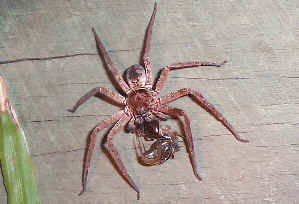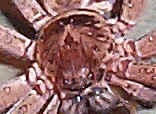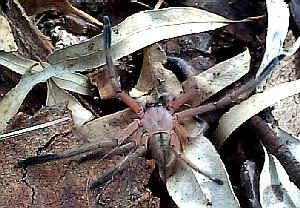|
| |
- This page contains pictures and information about Huntsman Spiders that we
found in the Brisbane area, Queensland, Australia.
-
 - Huntsman Spider
-
- Huntsman Spiders are large to very large size spiders. Most of them have flattened
body suitable to live inside the narrow gaps under bark, log and stone. They
are usually brown or grey in colours. The spiders
have crab-like legs - all legs bend forwards. They can walk backwards, forwards
and sideway. Their front two pairs of legs are usually much
longer than back. They run fast, hunt by chasing after prey. Sometimes they
come inside house looking for prey. If someone found spiders are scary, most
likely Huntsman Spiders are the major causes.
-


 - Eight eyes in two rows of four
Female, egg-sac and
juveniles
Crab-like legs
-
- Females make oval flat egg-sac under bark or between leaves. They will guard
the eggs and juveniles.
-

  - Day-time hiding under
bark
Night-time hunting on tree trunk
Some active during daytime
-
- Huntsman Spiders active during the night, They hide in their retreat, under
bark or some other shelter, during the day. Instead of chasing prey, most
huntsman spiders wait at the spots where
insects will come by. It is believe
that the coming and going of insects put down scent trails that the huntsmen
can pick up.
-
- Huntsman Spiders have eight eyes in two row of four, all dark in colour.
They are believed to have poor eye-sight.
- Brown Huntsman Spider 1

  - Heteropoda jugulans or H. cervina, leg to leg 70mm
- The spider's body and the hairy legs are brown in colour. Notice the 'X' mark on
carapace (small photo). Sometimes they will come indoors and run around on our walls and ceilings. We have
detail information and pictures about this spider in this page.
-
-
- Brown Huntsman Spider 2

 - Heteropoda sp., leg
to leg 40mm
- Found this huntsman spider in Karawatha Forest. It was resting on a gum
leaf. Check this page for more information.
-
-
- Bark Huntsman Spider

 - Pediana regina, leg to leg 50mm
- This spider has a Y-shaped pattern on its back. It was found
hunting on tree trunk and had the flattened body. The patterns on the upper
surfaces of thorax and abdomen are distinctive. Please also check this page
for more details.
-
-
- Giant Grey Huntsman Spider 1

 - Holconia immanis (former Isopeda immanis), leg to leg 100mm
- This is a very large spider, one of the largest Huntsmen found in
Australia. The body is reddish grey in colour, with brown white bended legs.
There is the dark brown dagger pattern on top of abdomen. Pictures show a
male. Female is even larger, has the relatively larger abdomen and smaller
palps, otherwise look the same. Please click on here
for more pictures and information.
-
-
- Giant Grey Huntsman Spider 2

 - Isopeda sp., leg to leg 80mm
- The spider in the above photo was found sun-bathing outside its nest,
which was under the bark just next to it. Check this page
for more infromation.
-
-
- Giant Green Huntsman Spider
 
 - Adult female with
egg-sac
Young
Juvenile
- Isopoda sp., adult leg to leg 80mm
- This huntsman spider is common in Karawatha Forest. Notice its front two pairs of legs are much longer than tha back. Click
here for more pictures and information on
this spider.
-
-
- Mountain Huntsman Spider

 - Isopeda montana, leg to leg 50mm
- We found this huntsman spider in Anstead Forest on Aug 2009. This huntsman
is relatively colourful. Notice on of its front leg is smaller and different.
It could be a new leg replaced the broken one. Please also check this page
for more information.
-
-
- Shield Huntsman Spider 1
  - Neosparassus salacius (former Olios salacius), leg to leg 80mm
- We found this Shield Huntsman Spider (also know as Badge Huntsman Spider)
in a shelter made by silk and leaves on a gum tree. When we examined its
shelter, the spider jumped onto the ground and quickly ran away. The spider is pale brown in
colour, no marking on the thorax. Please visit this page
for more pictures and information.
-
-
- Shield Huntsman Spider 2

 - Neosparassus sp. (former Olios sp.), leg to leg
50mm
- We
found this orange brown huntsman spider on the floor of Karawatha Forest. Its
legs were thick. We think this could the the young Shield Huntsman Spider or
related species. Check this page for more
information.
-
-
- Unknown
Huntsman 1

 - ? Neosparassus sp.
leg to leg 30mm
- 1.
Unknown sparassid
- The Find-a-spider Guide for Australian
Spiders, University of Southern Queensland, 2007
- 2. Spiders - family Sparassidae
- lifeunseen.com,
by Nick Monaghan,
2009.
-
-
- Flat Huntsman Spider
 - Delena cancerides, leg to leg 100mm
- This very large spider was hiding under the lose bark of a gum tree. Its thorax was round and brown in
colour, with a 'X' mark on its carapace. It ran very fast. After I
took this picture, it ran away up to the gum tree and disappeared in a
second. More information can be found in this page.
-
-
- Unknown
Huntsman 1
 - ? Neosparassus sp.
leg to leg 30mm
-
-
- Unknown
Huntsman 2
 - Body length 10mm
-
-
- Unknown
Huntsman 3
 
 - ? sp.
leg to leg 50mm
 - Found quite a few of them hiding under bark on Mar 2011 in Ford Road
Conservation Area.
- Reference:
- 1. A Guide to Australian Spiders - Densey Clyne, Melbourne, Nelson
1969, p55.
- 2. Australian Spiders in colour - Ramon Mascord, Reed Books Pty Ltd,
1970, p32.
- 3. Sparassidae
-
The Find-a-spider Guide for Australian
Spiders, University of Southern Queensland, 2009.
- 4. SPARASSIDAE
Huntsman spiders - Save Our Waterways Now.
- 5. Family
SPARASSIDAE Bertkau, 1872 - Australian Faunal Directory, Australian Biological
Resources Study.
- 6. Huntsman - Spiders of Australia, by Ed Nieuwenhuys, 2006.
- 7. Spiders - family Sparassidae
- lifeunseen.com,
by Nick Monaghan,
2009.
- Back to top
[ Up ] [ Two-Tails Spiders ] [ Lynx spiders ] [ Wolf spiders ] [ Water Spiders ] [ Ground Hunting Spiders ] [ Long-legged Sac Spiders ] [ Swift spiders ] [ Wall crab spiders ] [ Huntsman Spiders ] [ Crab Spiders ] [ Unknown Hunting Spiders ]
| |
|




































